Network and System Management Report: Future Needs and Misalignment
VerifiedAdded on 2020/12/28
|12
|3403
|303
Report
AI Summary
This report analyzes network and system management, focusing on Fragile Transportation's IT environment. It addresses the impact of future needs while maintaining service levels, emphasizing resource and QoS monitoring using tools like Ping and SNMP. The report outlines system infrastructure upgrades, including risk assessment and SLA implementation at consumer, corporate, and service levels. It also explores IT service management systems (ITSM), the implementation process, and potential misalignments in IT services, particularly in multinational companies, highlighting factors like dynamic market trends and cost considerations that contribute to these discrepancies. The report emphasizes the need for continuous service improvement and proactive management of potential incidents within the ITSM framework to ensure optimal performance and alignment with business objectives.
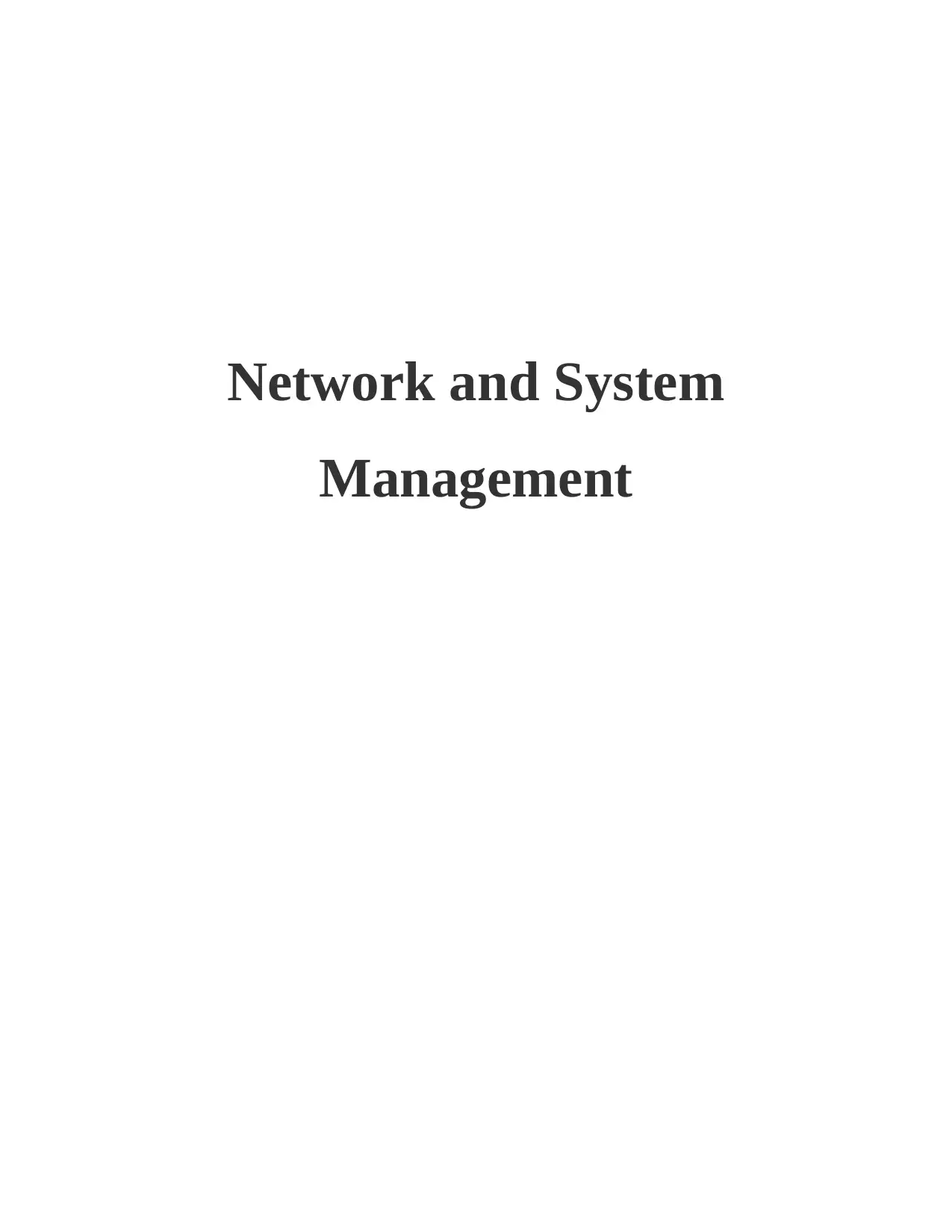
Network and System
Management
Management
Paraphrase This Document
Need a fresh take? Get an instant paraphrase of this document with our AI Paraphraser
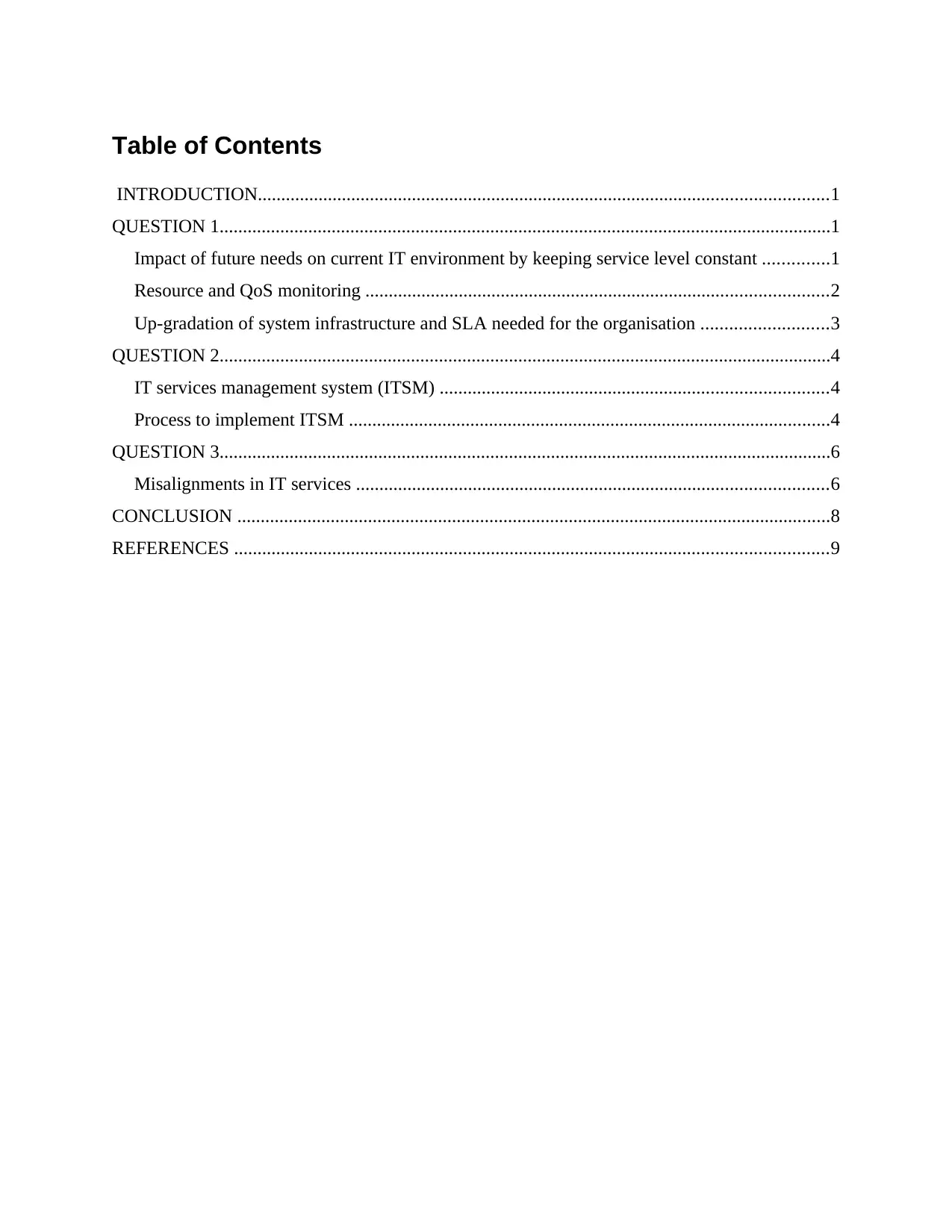
Table of Contents
INTRODUCTION..........................................................................................................................1
QUESTION 1...................................................................................................................................1
Impact of future needs on current IT environment by keeping service level constant ..............1
Resource and QoS monitoring ...................................................................................................2
Up-gradation of system infrastructure and SLA needed for the organisation ...........................3
QUESTION 2...................................................................................................................................4
IT services management system (ITSM) ...................................................................................4
Process to implement ITSM .......................................................................................................4
QUESTION 3...................................................................................................................................6
Misalignments in IT services .....................................................................................................6
CONCLUSION ...............................................................................................................................8
REFERENCES ...............................................................................................................................9
INTRODUCTION..........................................................................................................................1
QUESTION 1...................................................................................................................................1
Impact of future needs on current IT environment by keeping service level constant ..............1
Resource and QoS monitoring ...................................................................................................2
Up-gradation of system infrastructure and SLA needed for the organisation ...........................3
QUESTION 2...................................................................................................................................4
IT services management system (ITSM) ...................................................................................4
Process to implement ITSM .......................................................................................................4
QUESTION 3...................................................................................................................................6
Misalignments in IT services .....................................................................................................6
CONCLUSION ...............................................................................................................................8
REFERENCES ...............................................................................................................................9
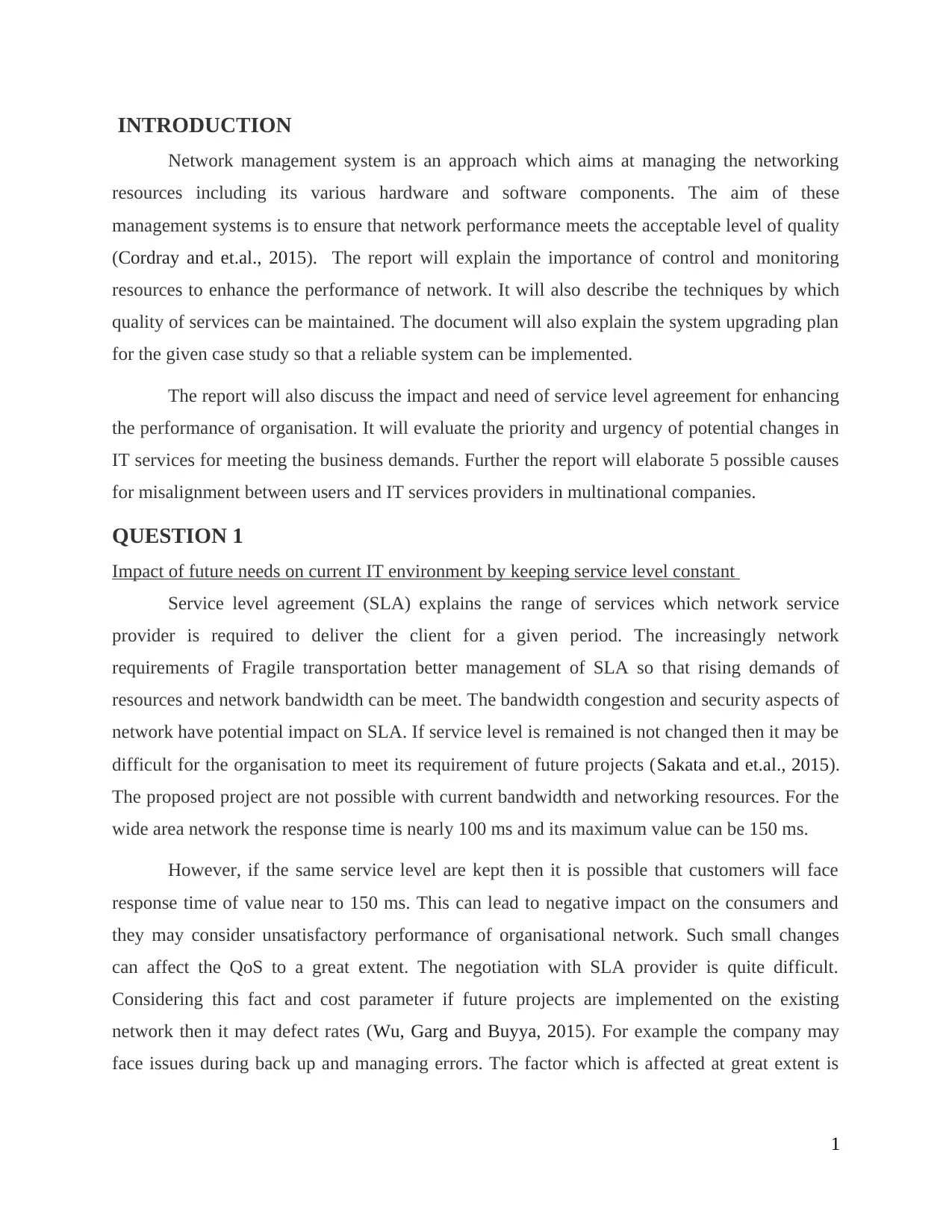
INTRODUCTION
Network management system is an approach which aims at managing the networking
resources including its various hardware and software components. The aim of these
management systems is to ensure that network performance meets the acceptable level of quality
(Cordray and et.al., 2015). The report will explain the importance of control and monitoring
resources to enhance the performance of network. It will also describe the techniques by which
quality of services can be maintained. The document will also explain the system upgrading plan
for the given case study so that a reliable system can be implemented.
The report will also discuss the impact and need of service level agreement for enhancing
the performance of organisation. It will evaluate the priority and urgency of potential changes in
IT services for meeting the business demands. Further the report will elaborate 5 possible causes
for misalignment between users and IT services providers in multinational companies.
QUESTION 1
Impact of future needs on current IT environment by keeping service level constant
Service level agreement (SLA) explains the range of services which network service
provider is required to deliver the client for a given period. The increasingly network
requirements of Fragile transportation better management of SLA so that rising demands of
resources and network bandwidth can be meet. The bandwidth congestion and security aspects of
network have potential impact on SLA. If service level is remained is not changed then it may be
difficult for the organisation to meet its requirement of future projects (Sakata and et.al., 2015).
The proposed project are not possible with current bandwidth and networking resources. For the
wide area network the response time is nearly 100 ms and its maximum value can be 150 ms.
However, if the same service level are kept then it is possible that customers will face
response time of value near to 150 ms. This can lead to negative impact on the consumers and
they may consider unsatisfactory performance of organisational network. Such small changes
can affect the QoS to a great extent. The negotiation with SLA provider is quite difficult.
Considering this fact and cost parameter if future projects are implemented on the existing
network then it may defect rates (Wu, Garg and Buyya, 2015). For example the company may
face issues during back up and managing errors. The factor which is affected at great extent is
1
Network management system is an approach which aims at managing the networking
resources including its various hardware and software components. The aim of these
management systems is to ensure that network performance meets the acceptable level of quality
(Cordray and et.al., 2015). The report will explain the importance of control and monitoring
resources to enhance the performance of network. It will also describe the techniques by which
quality of services can be maintained. The document will also explain the system upgrading plan
for the given case study so that a reliable system can be implemented.
The report will also discuss the impact and need of service level agreement for enhancing
the performance of organisation. It will evaluate the priority and urgency of potential changes in
IT services for meeting the business demands. Further the report will elaborate 5 possible causes
for misalignment between users and IT services providers in multinational companies.
QUESTION 1
Impact of future needs on current IT environment by keeping service level constant
Service level agreement (SLA) explains the range of services which network service
provider is required to deliver the client for a given period. The increasingly network
requirements of Fragile transportation better management of SLA so that rising demands of
resources and network bandwidth can be meet. The bandwidth congestion and security aspects of
network have potential impact on SLA. If service level is remained is not changed then it may be
difficult for the organisation to meet its requirement of future projects (Sakata and et.al., 2015).
The proposed project are not possible with current bandwidth and networking resources. For the
wide area network the response time is nearly 100 ms and its maximum value can be 150 ms.
However, if the same service level are kept then it is possible that customers will face
response time of value near to 150 ms. This can lead to negative impact on the consumers and
they may consider unsatisfactory performance of organisational network. Such small changes
can affect the QoS to a great extent. The negotiation with SLA provider is quite difficult.
Considering this fact and cost parameter if future projects are implemented on the existing
network then it may defect rates (Wu, Garg and Buyya, 2015). For example the company may
face issues during back up and managing errors. The factor which is affected at great extent is
1
⊘ This is a preview!⊘
Do you want full access?
Subscribe today to unlock all pages.

Trusted by 1+ million students worldwide
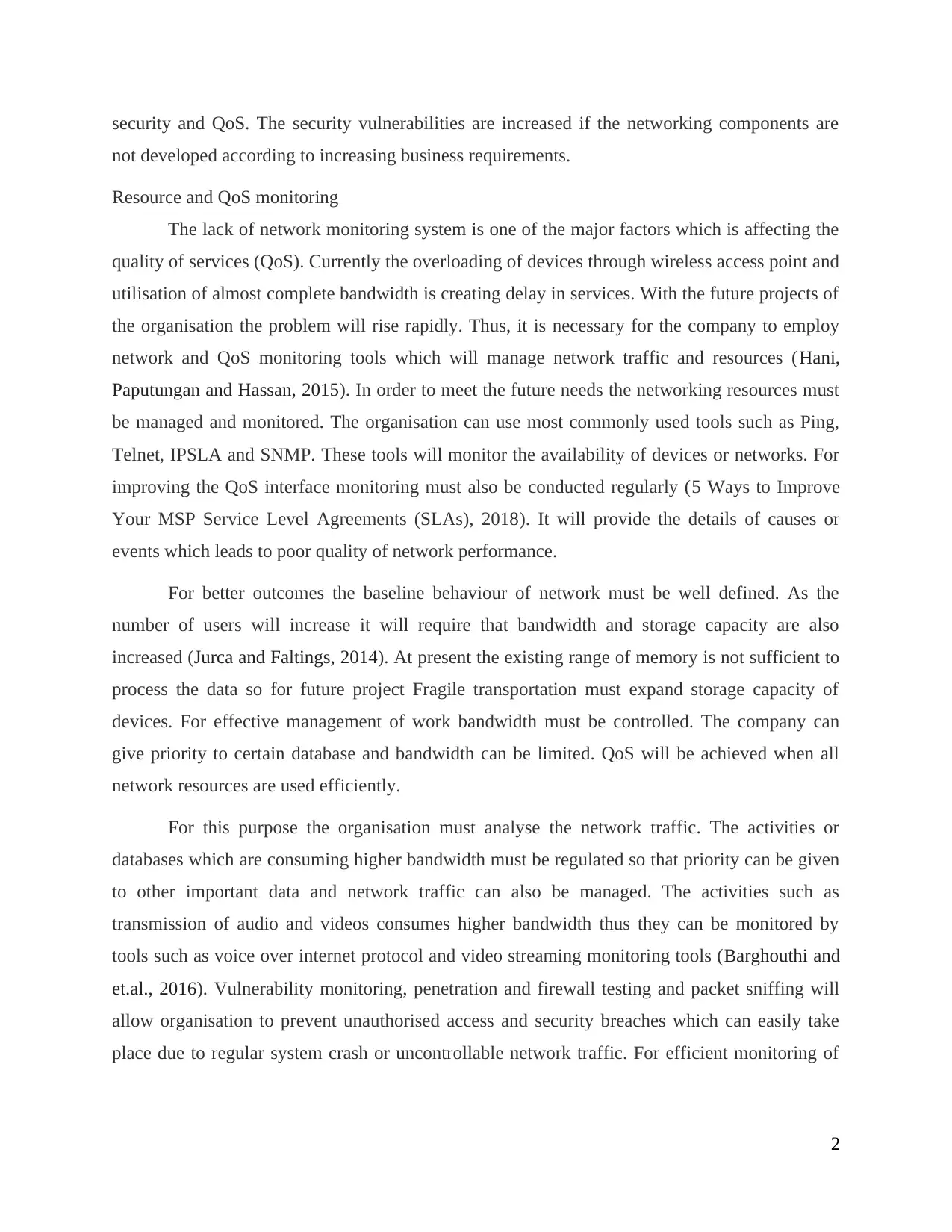
security and QoS. The security vulnerabilities are increased if the networking components are
not developed according to increasing business requirements.
Resource and QoS monitoring
The lack of network monitoring system is one of the major factors which is affecting the
quality of services (QoS). Currently the overloading of devices through wireless access point and
utilisation of almost complete bandwidth is creating delay in services. With the future projects of
the organisation the problem will rise rapidly. Thus, it is necessary for the company to employ
network and QoS monitoring tools which will manage network traffic and resources (Hani,
Paputungan and Hassan, 2015). In order to meet the future needs the networking resources must
be managed and monitored. The organisation can use most commonly used tools such as Ping,
Telnet, IPSLA and SNMP. These tools will monitor the availability of devices or networks. For
improving the QoS interface monitoring must also be conducted regularly (5 Ways to Improve
Your MSP Service Level Agreements (SLAs), 2018). It will provide the details of causes or
events which leads to poor quality of network performance.
For better outcomes the baseline behaviour of network must be well defined. As the
number of users will increase it will require that bandwidth and storage capacity are also
increased (Jurca and Faltings, 2014). At present the existing range of memory is not sufficient to
process the data so for future project Fragile transportation must expand storage capacity of
devices. For effective management of work bandwidth must be controlled. The company can
give priority to certain database and bandwidth can be limited. QoS will be achieved when all
network resources are used efficiently.
For this purpose the organisation must analyse the network traffic. The activities or
databases which are consuming higher bandwidth must be regulated so that priority can be given
to other important data and network traffic can also be managed. The activities such as
transmission of audio and videos consumes higher bandwidth thus they can be monitored by
tools such as voice over internet protocol and video streaming monitoring tools (Barghouthi and
et.al., 2016). Vulnerability monitoring, penetration and firewall testing and packet sniffing will
allow organisation to prevent unauthorised access and security breaches which can easily take
place due to regular system crash or uncontrollable network traffic. For efficient monitoring of
2
not developed according to increasing business requirements.
Resource and QoS monitoring
The lack of network monitoring system is one of the major factors which is affecting the
quality of services (QoS). Currently the overloading of devices through wireless access point and
utilisation of almost complete bandwidth is creating delay in services. With the future projects of
the organisation the problem will rise rapidly. Thus, it is necessary for the company to employ
network and QoS monitoring tools which will manage network traffic and resources (Hani,
Paputungan and Hassan, 2015). In order to meet the future needs the networking resources must
be managed and monitored. The organisation can use most commonly used tools such as Ping,
Telnet, IPSLA and SNMP. These tools will monitor the availability of devices or networks. For
improving the QoS interface monitoring must also be conducted regularly (5 Ways to Improve
Your MSP Service Level Agreements (SLAs), 2018). It will provide the details of causes or
events which leads to poor quality of network performance.
For better outcomes the baseline behaviour of network must be well defined. As the
number of users will increase it will require that bandwidth and storage capacity are also
increased (Jurca and Faltings, 2014). At present the existing range of memory is not sufficient to
process the data so for future project Fragile transportation must expand storage capacity of
devices. For effective management of work bandwidth must be controlled. The company can
give priority to certain database and bandwidth can be limited. QoS will be achieved when all
network resources are used efficiently.
For this purpose the organisation must analyse the network traffic. The activities or
databases which are consuming higher bandwidth must be regulated so that priority can be given
to other important data and network traffic can also be managed. The activities such as
transmission of audio and videos consumes higher bandwidth thus they can be monitored by
tools such as voice over internet protocol and video streaming monitoring tools (Barghouthi and
et.al., 2016). Vulnerability monitoring, penetration and firewall testing and packet sniffing will
allow organisation to prevent unauthorised access and security breaches which can easily take
place due to regular system crash or uncontrollable network traffic. For efficient monitoring of
2
Paraphrase This Document
Need a fresh take? Get an instant paraphrase of this document with our AI Paraphraser
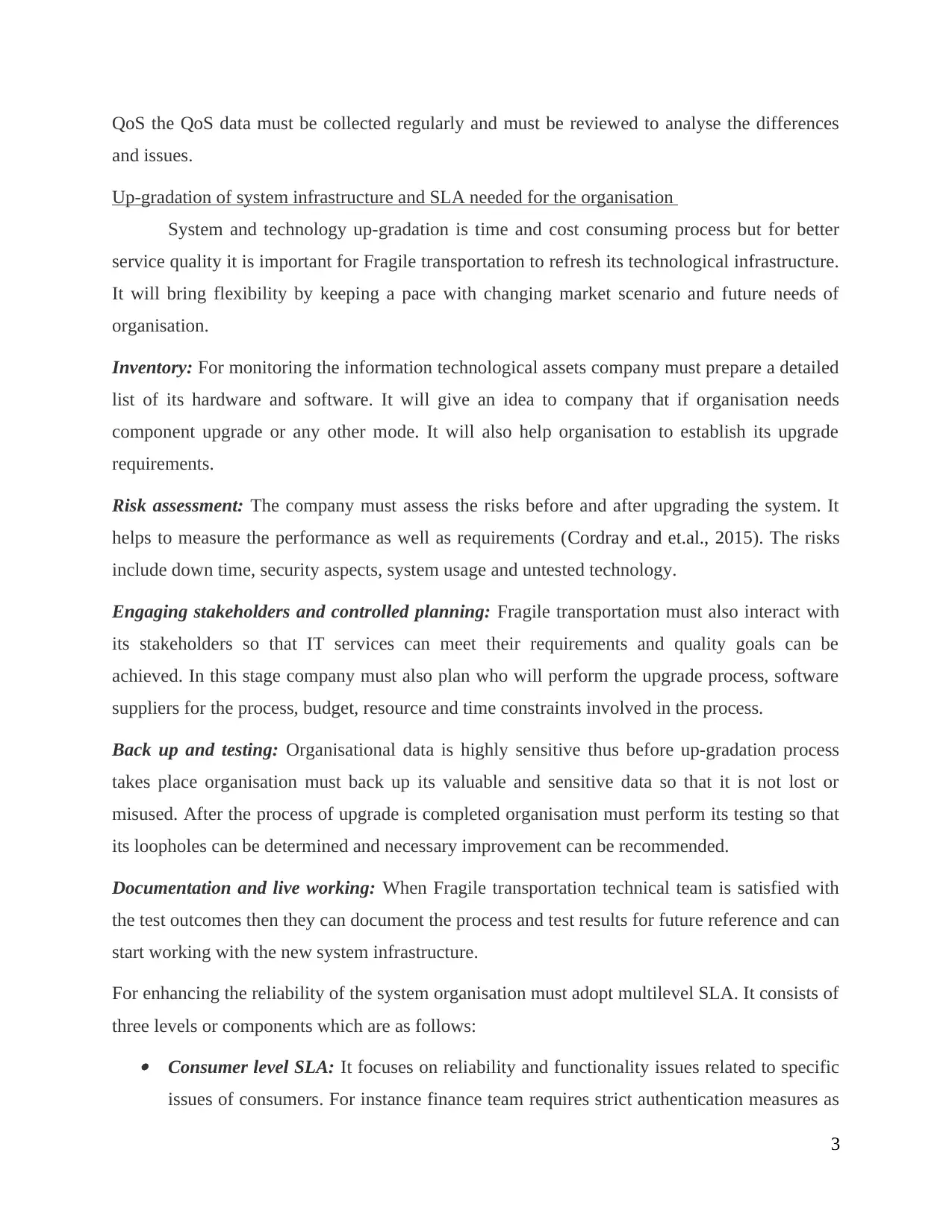
QoS the QoS data must be collected regularly and must be reviewed to analyse the differences
and issues.
Up-gradation of system infrastructure and SLA needed for the organisation
System and technology up-gradation is time and cost consuming process but for better
service quality it is important for Fragile transportation to refresh its technological infrastructure.
It will bring flexibility by keeping a pace with changing market scenario and future needs of
organisation.
Inventory: For monitoring the information technological assets company must prepare a detailed
list of its hardware and software. It will give an idea to company that if organisation needs
component upgrade or any other mode. It will also help organisation to establish its upgrade
requirements.
Risk assessment: The company must assess the risks before and after upgrading the system. It
helps to measure the performance as well as requirements (Cordray and et.al., 2015). The risks
include down time, security aspects, system usage and untested technology.
Engaging stakeholders and controlled planning: Fragile transportation must also interact with
its stakeholders so that IT services can meet their requirements and quality goals can be
achieved. In this stage company must also plan who will perform the upgrade process, software
suppliers for the process, budget, resource and time constraints involved in the process.
Back up and testing: Organisational data is highly sensitive thus before up-gradation process
takes place organisation must back up its valuable and sensitive data so that it is not lost or
misused. After the process of upgrade is completed organisation must perform its testing so that
its loopholes can be determined and necessary improvement can be recommended.
Documentation and live working: When Fragile transportation technical team is satisfied with
the test outcomes then they can document the process and test results for future reference and can
start working with the new system infrastructure.
For enhancing the reliability of the system organisation must adopt multilevel SLA. It consists of
three levels or components which are as follows: Consumer level SLA: It focuses on reliability and functionality issues related to specific
issues of consumers. For instance finance team requires strict authentication measures as
3
and issues.
Up-gradation of system infrastructure and SLA needed for the organisation
System and technology up-gradation is time and cost consuming process but for better
service quality it is important for Fragile transportation to refresh its technological infrastructure.
It will bring flexibility by keeping a pace with changing market scenario and future needs of
organisation.
Inventory: For monitoring the information technological assets company must prepare a detailed
list of its hardware and software. It will give an idea to company that if organisation needs
component upgrade or any other mode. It will also help organisation to establish its upgrade
requirements.
Risk assessment: The company must assess the risks before and after upgrading the system. It
helps to measure the performance as well as requirements (Cordray and et.al., 2015). The risks
include down time, security aspects, system usage and untested technology.
Engaging stakeholders and controlled planning: Fragile transportation must also interact with
its stakeholders so that IT services can meet their requirements and quality goals can be
achieved. In this stage company must also plan who will perform the upgrade process, software
suppliers for the process, budget, resource and time constraints involved in the process.
Back up and testing: Organisational data is highly sensitive thus before up-gradation process
takes place organisation must back up its valuable and sensitive data so that it is not lost or
misused. After the process of upgrade is completed organisation must perform its testing so that
its loopholes can be determined and necessary improvement can be recommended.
Documentation and live working: When Fragile transportation technical team is satisfied with
the test outcomes then they can document the process and test results for future reference and can
start working with the new system infrastructure.
For enhancing the reliability of the system organisation must adopt multilevel SLA. It consists of
three levels or components which are as follows: Consumer level SLA: It focuses on reliability and functionality issues related to specific
issues of consumers. For instance finance team requires strict authentication measures as
3
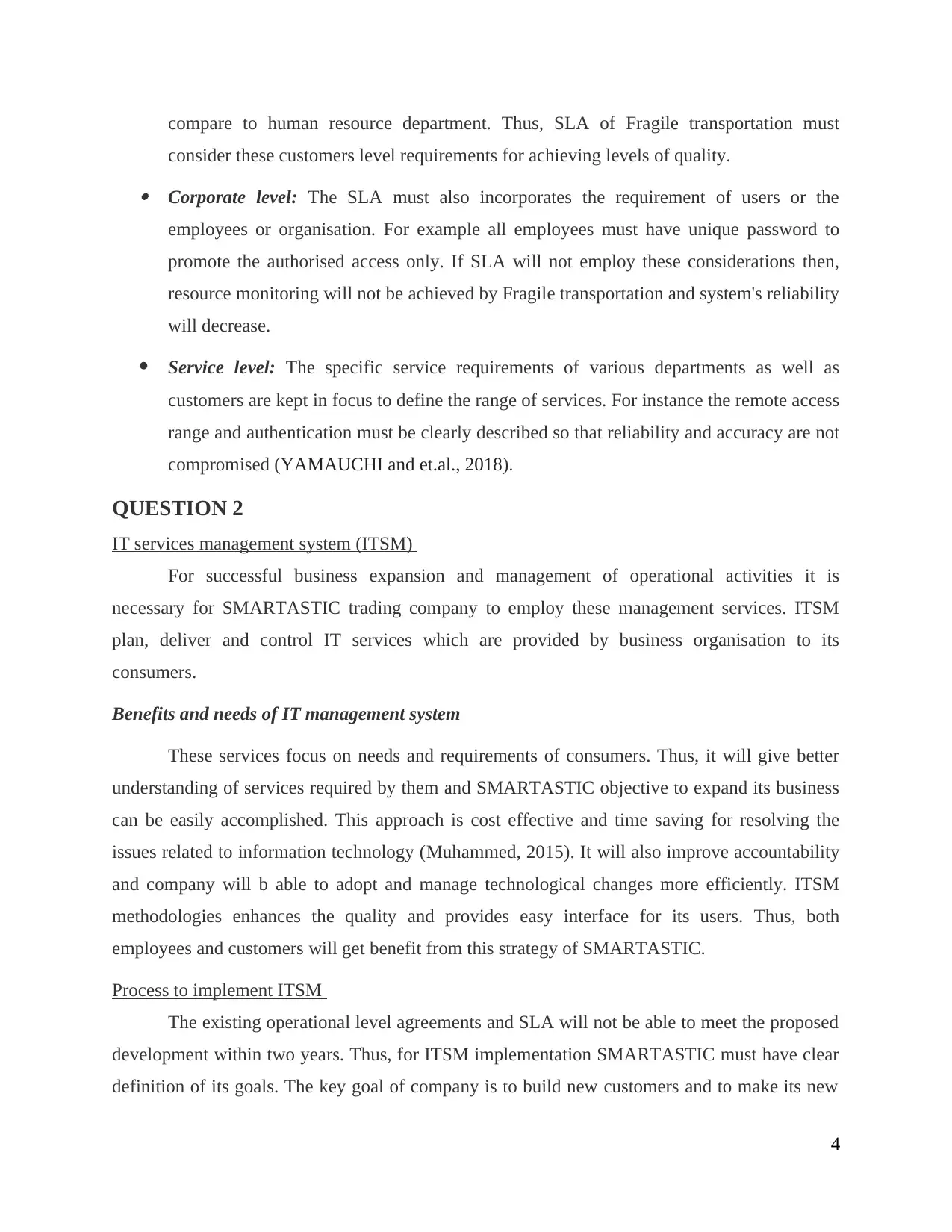
compare to human resource department. Thus, SLA of Fragile transportation must
consider these customers level requirements for achieving levels of quality. Corporate level: The SLA must also incorporates the requirement of users or the
employees or organisation. For example all employees must have unique password to
promote the authorised access only. If SLA will not employ these considerations then,
resource monitoring will not be achieved by Fragile transportation and system's reliability
will decrease.
Service level: The specific service requirements of various departments as well as
customers are kept in focus to define the range of services. For instance the remote access
range and authentication must be clearly described so that reliability and accuracy are not
compromised (YAMAUCHI and et.al., 2018).
QUESTION 2
IT services management system (ITSM)
For successful business expansion and management of operational activities it is
necessary for SMARTASTIC trading company to employ these management services. ITSM
plan, deliver and control IT services which are provided by business organisation to its
consumers.
Benefits and needs of IT management system
These services focus on needs and requirements of consumers. Thus, it will give better
understanding of services required by them and SMARTASTIC objective to expand its business
can be easily accomplished. This approach is cost effective and time saving for resolving the
issues related to information technology (Muhammed, 2015). It will also improve accountability
and company will b able to adopt and manage technological changes more efficiently. ITSM
methodologies enhances the quality and provides easy interface for its users. Thus, both
employees and customers will get benefit from this strategy of SMARTASTIC.
Process to implement ITSM
The existing operational level agreements and SLA will not be able to meet the proposed
development within two years. Thus, for ITSM implementation SMARTASTIC must have clear
definition of its goals. The key goal of company is to build new customers and to make its new
4
consider these customers level requirements for achieving levels of quality. Corporate level: The SLA must also incorporates the requirement of users or the
employees or organisation. For example all employees must have unique password to
promote the authorised access only. If SLA will not employ these considerations then,
resource monitoring will not be achieved by Fragile transportation and system's reliability
will decrease.
Service level: The specific service requirements of various departments as well as
customers are kept in focus to define the range of services. For instance the remote access
range and authentication must be clearly described so that reliability and accuracy are not
compromised (YAMAUCHI and et.al., 2018).
QUESTION 2
IT services management system (ITSM)
For successful business expansion and management of operational activities it is
necessary for SMARTASTIC trading company to employ these management services. ITSM
plan, deliver and control IT services which are provided by business organisation to its
consumers.
Benefits and needs of IT management system
These services focus on needs and requirements of consumers. Thus, it will give better
understanding of services required by them and SMARTASTIC objective to expand its business
can be easily accomplished. This approach is cost effective and time saving for resolving the
issues related to information technology (Muhammed, 2015). It will also improve accountability
and company will b able to adopt and manage technological changes more efficiently. ITSM
methodologies enhances the quality and provides easy interface for its users. Thus, both
employees and customers will get benefit from this strategy of SMARTASTIC.
Process to implement ITSM
The existing operational level agreements and SLA will not be able to meet the proposed
development within two years. Thus, for ITSM implementation SMARTASTIC must have clear
definition of its goals. The key goal of company is to build new customers and to make its new
4
⊘ This is a preview!⊘
Do you want full access?
Subscribe today to unlock all pages.

Trusted by 1+ million students worldwide
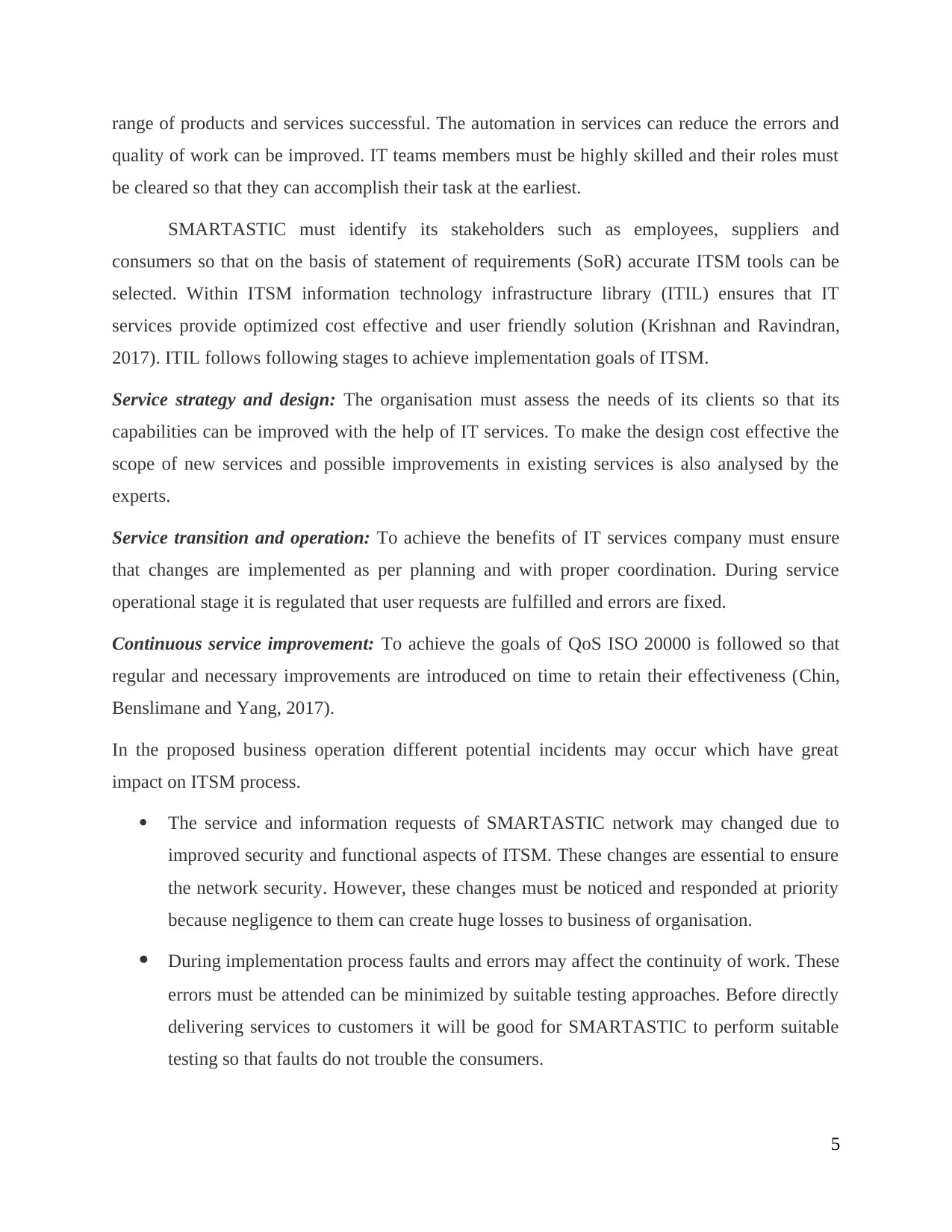
range of products and services successful. The automation in services can reduce the errors and
quality of work can be improved. IT teams members must be highly skilled and their roles must
be cleared so that they can accomplish their task at the earliest.
SMARTASTIC must identify its stakeholders such as employees, suppliers and
consumers so that on the basis of statement of requirements (SoR) accurate ITSM tools can be
selected. Within ITSM information technology infrastructure library (ITIL) ensures that IT
services provide optimized cost effective and user friendly solution (Krishnan and Ravindran,
2017). ITIL follows following stages to achieve implementation goals of ITSM.
Service strategy and design: The organisation must assess the needs of its clients so that its
capabilities can be improved with the help of IT services. To make the design cost effective the
scope of new services and possible improvements in existing services is also analysed by the
experts.
Service transition and operation: To achieve the benefits of IT services company must ensure
that changes are implemented as per planning and with proper coordination. During service
operational stage it is regulated that user requests are fulfilled and errors are fixed.
Continuous service improvement: To achieve the goals of QoS ISO 20000 is followed so that
regular and necessary improvements are introduced on time to retain their effectiveness (Chin,
Benslimane and Yang, 2017).
In the proposed business operation different potential incidents may occur which have great
impact on ITSM process.
The service and information requests of SMARTASTIC network may changed due to
improved security and functional aspects of ITSM. These changes are essential to ensure
the network security. However, these changes must be noticed and responded at priority
because negligence to them can create huge losses to business of organisation.
During implementation process faults and errors may affect the continuity of work. These
errors must be attended can be minimized by suitable testing approaches. Before directly
delivering services to customers it will be good for SMARTASTIC to perform suitable
testing so that faults do not trouble the consumers.
5
quality of work can be improved. IT teams members must be highly skilled and their roles must
be cleared so that they can accomplish their task at the earliest.
SMARTASTIC must identify its stakeholders such as employees, suppliers and
consumers so that on the basis of statement of requirements (SoR) accurate ITSM tools can be
selected. Within ITSM information technology infrastructure library (ITIL) ensures that IT
services provide optimized cost effective and user friendly solution (Krishnan and Ravindran,
2017). ITIL follows following stages to achieve implementation goals of ITSM.
Service strategy and design: The organisation must assess the needs of its clients so that its
capabilities can be improved with the help of IT services. To make the design cost effective the
scope of new services and possible improvements in existing services is also analysed by the
experts.
Service transition and operation: To achieve the benefits of IT services company must ensure
that changes are implemented as per planning and with proper coordination. During service
operational stage it is regulated that user requests are fulfilled and errors are fixed.
Continuous service improvement: To achieve the goals of QoS ISO 20000 is followed so that
regular and necessary improvements are introduced on time to retain their effectiveness (Chin,
Benslimane and Yang, 2017).
In the proposed business operation different potential incidents may occur which have great
impact on ITSM process.
The service and information requests of SMARTASTIC network may changed due to
improved security and functional aspects of ITSM. These changes are essential to ensure
the network security. However, these changes must be noticed and responded at priority
because negligence to them can create huge losses to business of organisation.
During implementation process faults and errors may affect the continuity of work. These
errors must be attended can be minimized by suitable testing approaches. Before directly
delivering services to customers it will be good for SMARTASTIC to perform suitable
testing so that faults do not trouble the consumers.
5
Paraphrase This Document
Need a fresh take? Get an instant paraphrase of this document with our AI Paraphraser
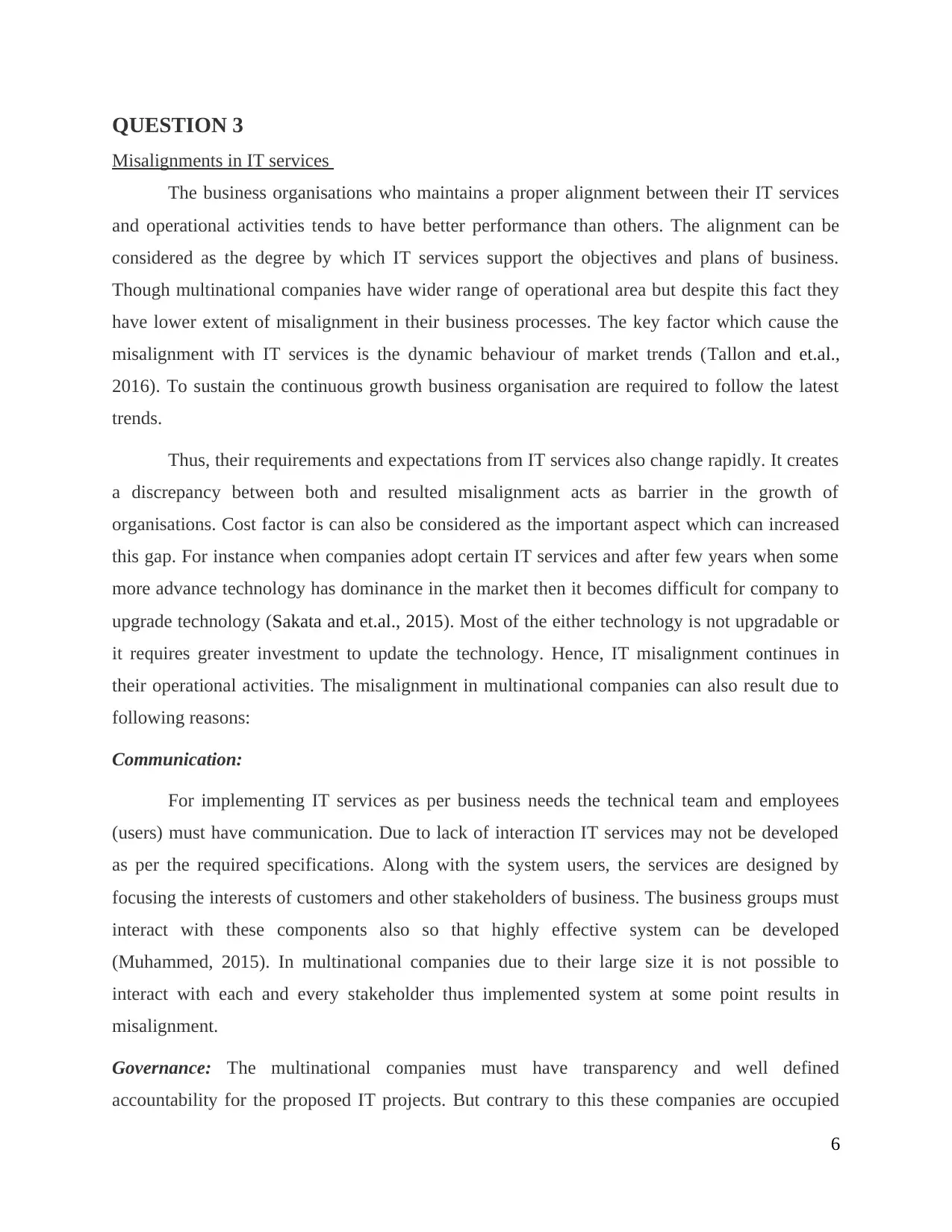
QUESTION 3
Misalignments in IT services
The business organisations who maintains a proper alignment between their IT services
and operational activities tends to have better performance than others. The alignment can be
considered as the degree by which IT services support the objectives and plans of business.
Though multinational companies have wider range of operational area but despite this fact they
have lower extent of misalignment in their business processes. The key factor which cause the
misalignment with IT services is the dynamic behaviour of market trends (Tallon and et.al.,
2016). To sustain the continuous growth business organisation are required to follow the latest
trends.
Thus, their requirements and expectations from IT services also change rapidly. It creates
a discrepancy between both and resulted misalignment acts as barrier in the growth of
organisations. Cost factor is can also be considered as the important aspect which can increased
this gap. For instance when companies adopt certain IT services and after few years when some
more advance technology has dominance in the market then it becomes difficult for company to
upgrade technology (Sakata and et.al., 2015). Most of the either technology is not upgradable or
it requires greater investment to update the technology. Hence, IT misalignment continues in
their operational activities. The misalignment in multinational companies can also result due to
following reasons:
Communication:
For implementing IT services as per business needs the technical team and employees
(users) must have communication. Due to lack of interaction IT services may not be developed
as per the required specifications. Along with the system users, the services are designed by
focusing the interests of customers and other stakeholders of business. The business groups must
interact with these components also so that highly effective system can be developed
(Muhammed, 2015). In multinational companies due to their large size it is not possible to
interact with each and every stakeholder thus implemented system at some point results in
misalignment.
Governance: The multinational companies must have transparency and well defined
accountability for the proposed IT projects. But contrary to this these companies are occupied
6
Misalignments in IT services
The business organisations who maintains a proper alignment between their IT services
and operational activities tends to have better performance than others. The alignment can be
considered as the degree by which IT services support the objectives and plans of business.
Though multinational companies have wider range of operational area but despite this fact they
have lower extent of misalignment in their business processes. The key factor which cause the
misalignment with IT services is the dynamic behaviour of market trends (Tallon and et.al.,
2016). To sustain the continuous growth business organisation are required to follow the latest
trends.
Thus, their requirements and expectations from IT services also change rapidly. It creates
a discrepancy between both and resulted misalignment acts as barrier in the growth of
organisations. Cost factor is can also be considered as the important aspect which can increased
this gap. For instance when companies adopt certain IT services and after few years when some
more advance technology has dominance in the market then it becomes difficult for company to
upgrade technology (Sakata and et.al., 2015). Most of the either technology is not upgradable or
it requires greater investment to update the technology. Hence, IT misalignment continues in
their operational activities. The misalignment in multinational companies can also result due to
following reasons:
Communication:
For implementing IT services as per business needs the technical team and employees
(users) must have communication. Due to lack of interaction IT services may not be developed
as per the required specifications. Along with the system users, the services are designed by
focusing the interests of customers and other stakeholders of business. The business groups must
interact with these components also so that highly effective system can be developed
(Muhammed, 2015). In multinational companies due to their large size it is not possible to
interact with each and every stakeholder thus implemented system at some point results in
misalignment.
Governance: The multinational companies must have transparency and well defined
accountability for the proposed IT projects. But contrary to this these companies are occupied
6
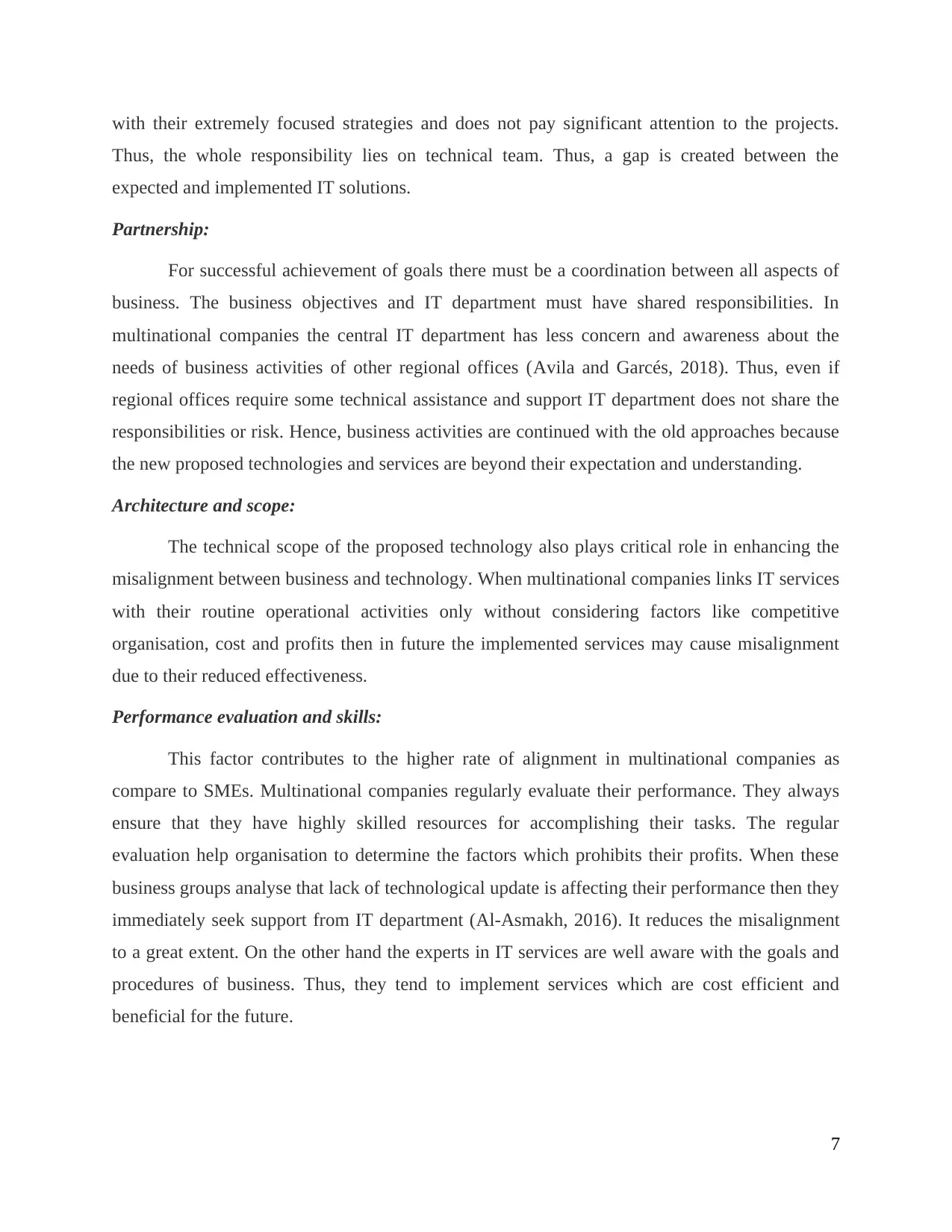
with their extremely focused strategies and does not pay significant attention to the projects.
Thus, the whole responsibility lies on technical team. Thus, a gap is created between the
expected and implemented IT solutions.
Partnership:
For successful achievement of goals there must be a coordination between all aspects of
business. The business objectives and IT department must have shared responsibilities. In
multinational companies the central IT department has less concern and awareness about the
needs of business activities of other regional offices (Avila and Garcés, 2018). Thus, even if
regional offices require some technical assistance and support IT department does not share the
responsibilities or risk. Hence, business activities are continued with the old approaches because
the new proposed technologies and services are beyond their expectation and understanding.
Architecture and scope:
The technical scope of the proposed technology also plays critical role in enhancing the
misalignment between business and technology. When multinational companies links IT services
with their routine operational activities only without considering factors like competitive
organisation, cost and profits then in future the implemented services may cause misalignment
due to their reduced effectiveness.
Performance evaluation and skills:
This factor contributes to the higher rate of alignment in multinational companies as
compare to SMEs. Multinational companies regularly evaluate their performance. They always
ensure that they have highly skilled resources for accomplishing their tasks. The regular
evaluation help organisation to determine the factors which prohibits their profits. When these
business groups analyse that lack of technological update is affecting their performance then they
immediately seek support from IT department (Al-Asmakh, 2016). It reduces the misalignment
to a great extent. On the other hand the experts in IT services are well aware with the goals and
procedures of business. Thus, they tend to implement services which are cost efficient and
beneficial for the future.
7
Thus, the whole responsibility lies on technical team. Thus, a gap is created between the
expected and implemented IT solutions.
Partnership:
For successful achievement of goals there must be a coordination between all aspects of
business. The business objectives and IT department must have shared responsibilities. In
multinational companies the central IT department has less concern and awareness about the
needs of business activities of other regional offices (Avila and Garcés, 2018). Thus, even if
regional offices require some technical assistance and support IT department does not share the
responsibilities or risk. Hence, business activities are continued with the old approaches because
the new proposed technologies and services are beyond their expectation and understanding.
Architecture and scope:
The technical scope of the proposed technology also plays critical role in enhancing the
misalignment between business and technology. When multinational companies links IT services
with their routine operational activities only without considering factors like competitive
organisation, cost and profits then in future the implemented services may cause misalignment
due to their reduced effectiveness.
Performance evaluation and skills:
This factor contributes to the higher rate of alignment in multinational companies as
compare to SMEs. Multinational companies regularly evaluate their performance. They always
ensure that they have highly skilled resources for accomplishing their tasks. The regular
evaluation help organisation to determine the factors which prohibits their profits. When these
business groups analyse that lack of technological update is affecting their performance then they
immediately seek support from IT department (Al-Asmakh, 2016). It reduces the misalignment
to a great extent. On the other hand the experts in IT services are well aware with the goals and
procedures of business. Thus, they tend to implement services which are cost efficient and
beneficial for the future.
7
⊘ This is a preview!⊘
Do you want full access?
Subscribe today to unlock all pages.

Trusted by 1+ million students worldwide
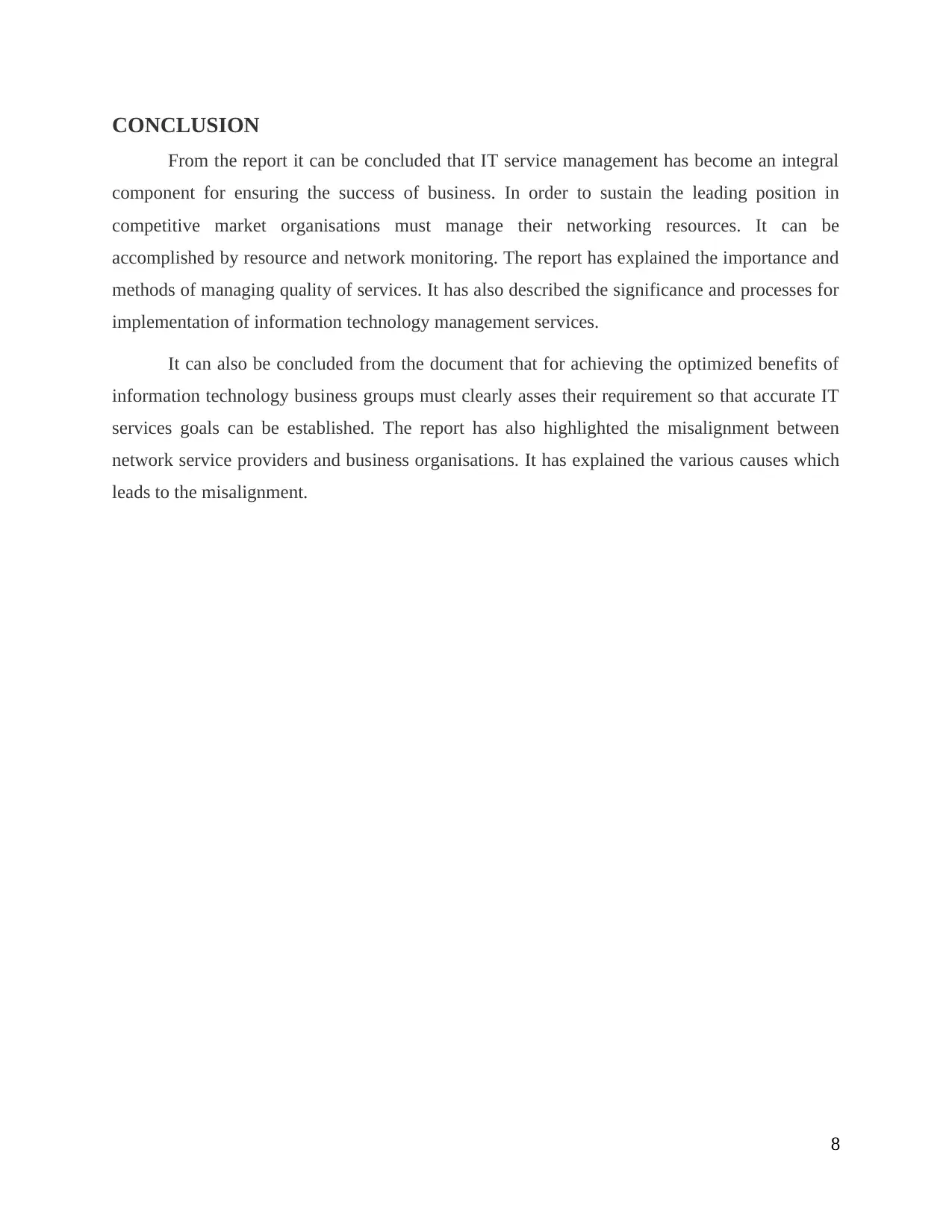
CONCLUSION
From the report it can be concluded that IT service management has become an integral
component for ensuring the success of business. In order to sustain the leading position in
competitive market organisations must manage their networking resources. It can be
accomplished by resource and network monitoring. The report has explained the importance and
methods of managing quality of services. It has also described the significance and processes for
implementation of information technology management services.
It can also be concluded from the document that for achieving the optimized benefits of
information technology business groups must clearly asses their requirement so that accurate IT
services goals can be established. The report has also highlighted the misalignment between
network service providers and business organisations. It has explained the various causes which
leads to the misalignment.
8
From the report it can be concluded that IT service management has become an integral
component for ensuring the success of business. In order to sustain the leading position in
competitive market organisations must manage their networking resources. It can be
accomplished by resource and network monitoring. The report has explained the importance and
methods of managing quality of services. It has also described the significance and processes for
implementation of information technology management services.
It can also be concluded from the document that for achieving the optimized benefits of
information technology business groups must clearly asses their requirement so that accurate IT
services goals can be established. The report has also highlighted the misalignment between
network service providers and business organisations. It has explained the various causes which
leads to the misalignment.
8
Paraphrase This Document
Need a fresh take? Get an instant paraphrase of this document with our AI Paraphraser
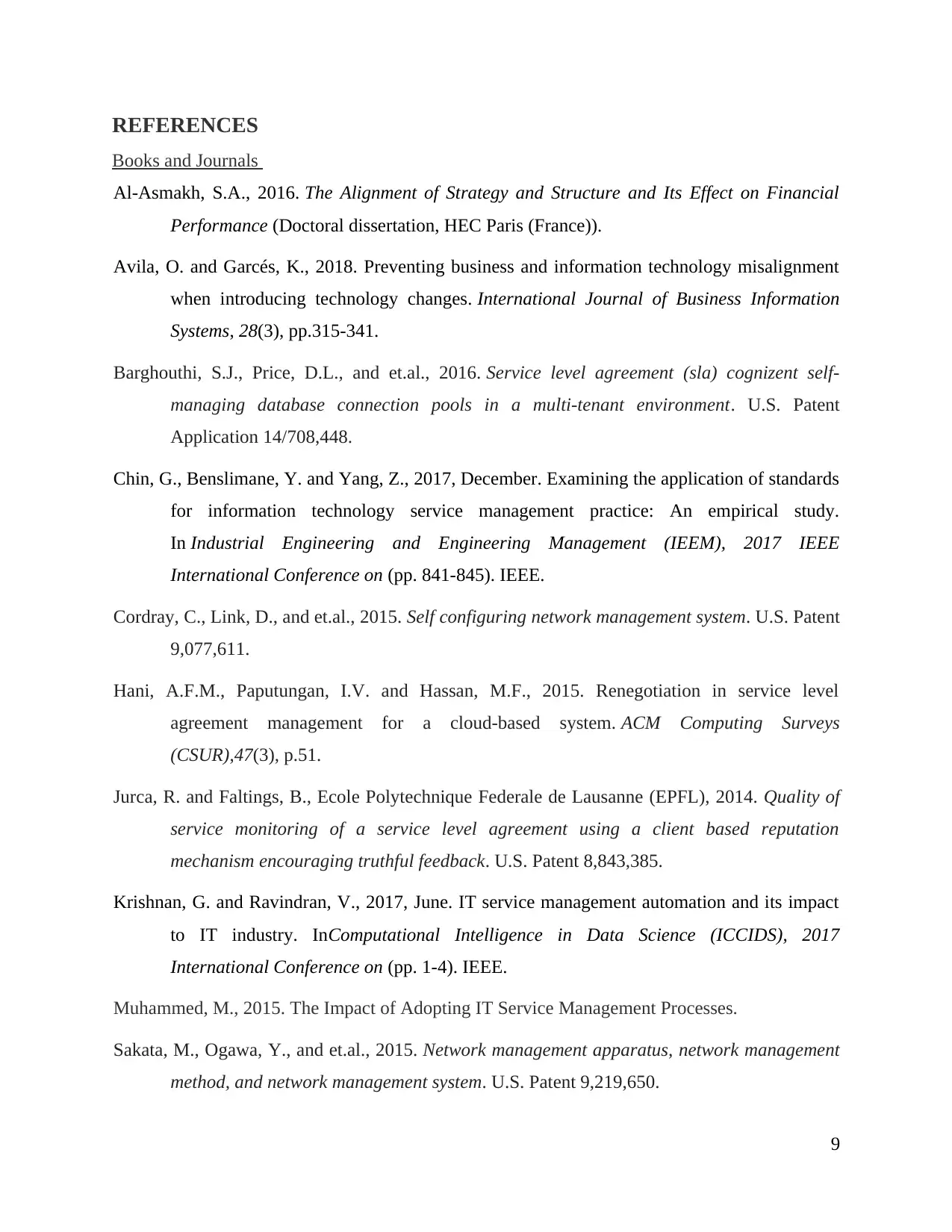
REFERENCES
Books and Journals
Al-Asmakh, S.A., 2016. The Alignment of Strategy and Structure and Its Effect on Financial
Performance (Doctoral dissertation, HEC Paris (France)).
Avila, O. and Garcés, K., 2018. Preventing business and information technology misalignment
when introducing technology changes. International Journal of Business Information
Systems, 28(3), pp.315-341.
Barghouthi, S.J., Price, D.L., and et.al., 2016. Service level agreement (sla) cognizent self-
managing database connection pools in a multi-tenant environment. U.S. Patent
Application 14/708,448.
Chin, G., Benslimane, Y. and Yang, Z., 2017, December. Examining the application of standards
for information technology service management practice: An empirical study.
In Industrial Engineering and Engineering Management (IEEM), 2017 IEEE
International Conference on (pp. 841-845). IEEE.
Cordray, C., Link, D., and et.al., 2015. Self configuring network management system. U.S. Patent
9,077,611.
Hani, A.F.M., Paputungan, I.V. and Hassan, M.F., 2015. Renegotiation in service level
agreement management for a cloud-based system. ACM Computing Surveys
(CSUR),47(3), p.51.
Jurca, R. and Faltings, B., Ecole Polytechnique Federale de Lausanne (EPFL), 2014. Quality of
service monitoring of a service level agreement using a client based reputation
mechanism encouraging truthful feedback. U.S. Patent 8,843,385.
Krishnan, G. and Ravindran, V., 2017, June. IT service management automation and its impact
to IT industry. InComputational Intelligence in Data Science (ICCIDS), 2017
International Conference on (pp. 1-4). IEEE.
Muhammed, M., 2015. The Impact of Adopting IT Service Management Processes.
Sakata, M., Ogawa, Y., and et.al., 2015. Network management apparatus, network management
method, and network management system. U.S. Patent 9,219,650.
9
Books and Journals
Al-Asmakh, S.A., 2016. The Alignment of Strategy and Structure and Its Effect on Financial
Performance (Doctoral dissertation, HEC Paris (France)).
Avila, O. and Garcés, K., 2018. Preventing business and information technology misalignment
when introducing technology changes. International Journal of Business Information
Systems, 28(3), pp.315-341.
Barghouthi, S.J., Price, D.L., and et.al., 2016. Service level agreement (sla) cognizent self-
managing database connection pools in a multi-tenant environment. U.S. Patent
Application 14/708,448.
Chin, G., Benslimane, Y. and Yang, Z., 2017, December. Examining the application of standards
for information technology service management practice: An empirical study.
In Industrial Engineering and Engineering Management (IEEM), 2017 IEEE
International Conference on (pp. 841-845). IEEE.
Cordray, C., Link, D., and et.al., 2015. Self configuring network management system. U.S. Patent
9,077,611.
Hani, A.F.M., Paputungan, I.V. and Hassan, M.F., 2015. Renegotiation in service level
agreement management for a cloud-based system. ACM Computing Surveys
(CSUR),47(3), p.51.
Jurca, R. and Faltings, B., Ecole Polytechnique Federale de Lausanne (EPFL), 2014. Quality of
service monitoring of a service level agreement using a client based reputation
mechanism encouraging truthful feedback. U.S. Patent 8,843,385.
Krishnan, G. and Ravindran, V., 2017, June. IT service management automation and its impact
to IT industry. InComputational Intelligence in Data Science (ICCIDS), 2017
International Conference on (pp. 1-4). IEEE.
Muhammed, M., 2015. The Impact of Adopting IT Service Management Processes.
Sakata, M., Ogawa, Y., and et.al., 2015. Network management apparatus, network management
method, and network management system. U.S. Patent 9,219,650.
9
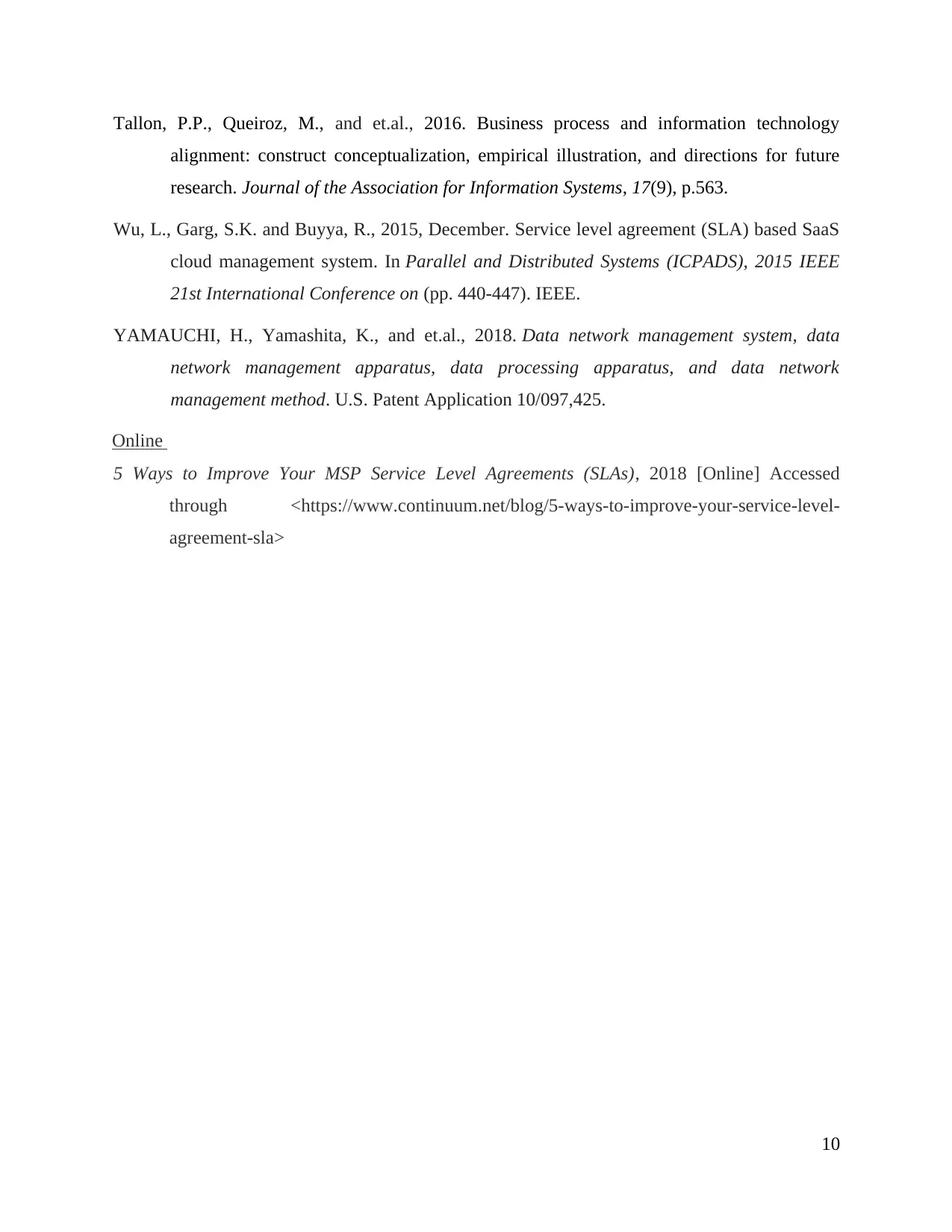
Tallon, P.P., Queiroz, M., and et.al., 2016. Business process and information technology
alignment: construct conceptualization, empirical illustration, and directions for future
research. Journal of the Association for Information Systems, 17(9), p.563.
Wu, L., Garg, S.K. and Buyya, R., 2015, December. Service level agreement (SLA) based SaaS
cloud management system. In Parallel and Distributed Systems (ICPADS), 2015 IEEE
21st International Conference on (pp. 440-447). IEEE.
YAMAUCHI, H., Yamashita, K., and et.al., 2018. Data network management system, data
network management apparatus, data processing apparatus, and data network
management method. U.S. Patent Application 10/097,425.
Online
5 Ways to Improve Your MSP Service Level Agreements (SLAs), 2018 [Online] Accessed
through <https://www.continuum.net/blog/5-ways-to-improve-your-service-level-
agreement-sla>
10
alignment: construct conceptualization, empirical illustration, and directions for future
research. Journal of the Association for Information Systems, 17(9), p.563.
Wu, L., Garg, S.K. and Buyya, R., 2015, December. Service level agreement (SLA) based SaaS
cloud management system. In Parallel and Distributed Systems (ICPADS), 2015 IEEE
21st International Conference on (pp. 440-447). IEEE.
YAMAUCHI, H., Yamashita, K., and et.al., 2018. Data network management system, data
network management apparatus, data processing apparatus, and data network
management method. U.S. Patent Application 10/097,425.
Online
5 Ways to Improve Your MSP Service Level Agreements (SLAs), 2018 [Online] Accessed
through <https://www.continuum.net/blog/5-ways-to-improve-your-service-level-
agreement-sla>
10
⊘ This is a preview!⊘
Do you want full access?
Subscribe today to unlock all pages.

Trusted by 1+ million students worldwide
1 out of 12
Related Documents
Your All-in-One AI-Powered Toolkit for Academic Success.
+13062052269
info@desklib.com
Available 24*7 on WhatsApp / Email
![[object Object]](/_next/static/media/star-bottom.7253800d.svg)
Unlock your academic potential
Copyright © 2020–2025 A2Z Services. All Rights Reserved. Developed and managed by ZUCOL.





